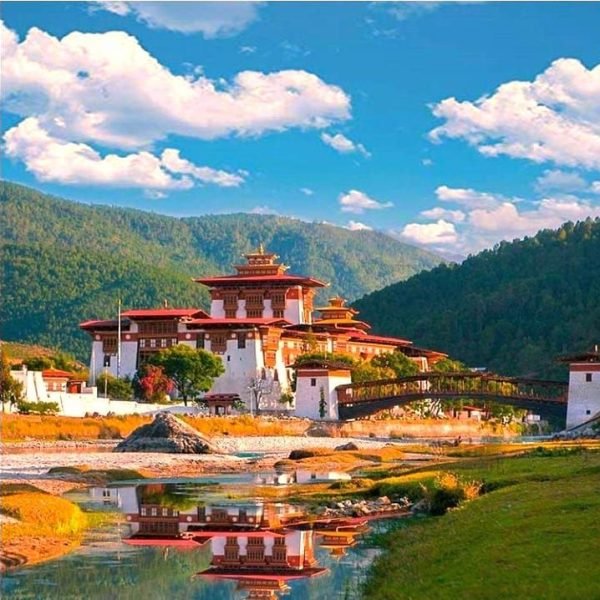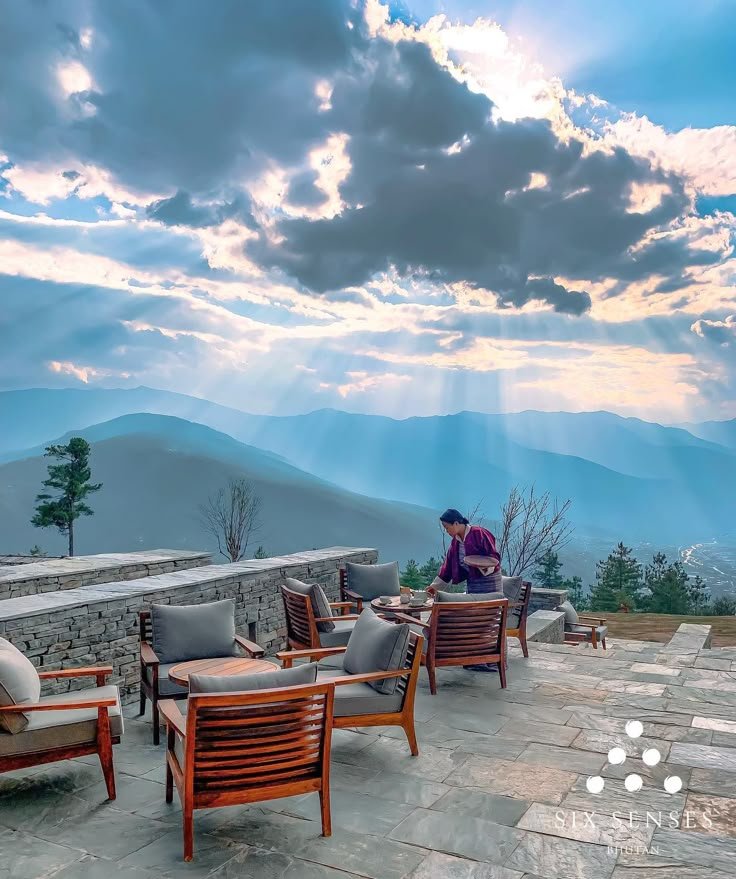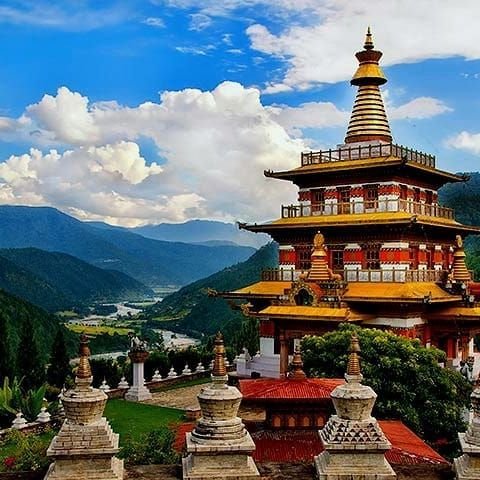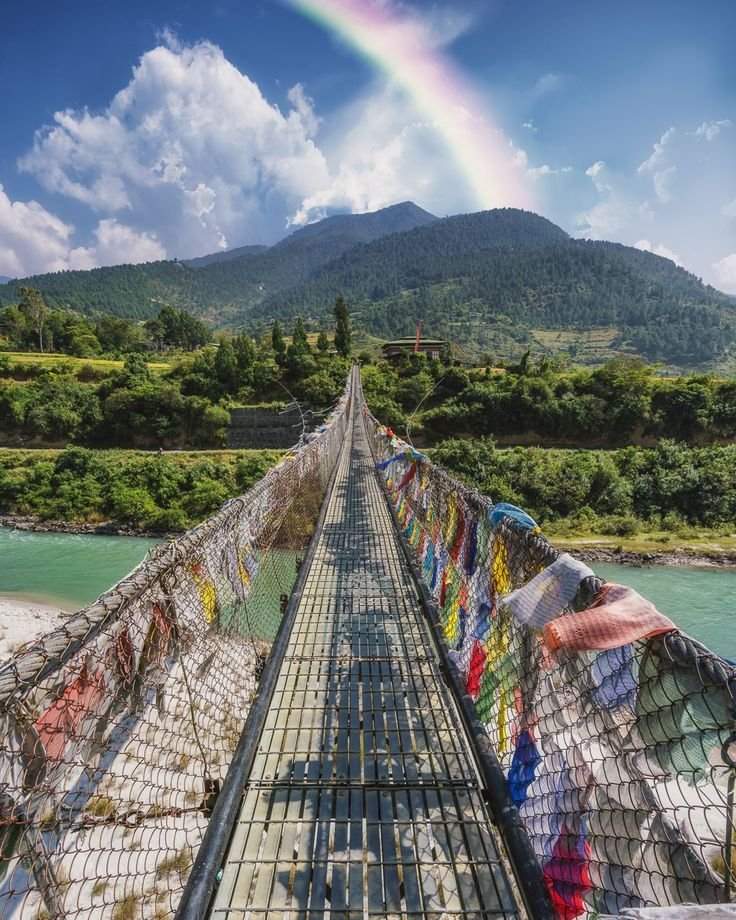Bhutan
Welcome to Bhutan
Bhutan, often referred to as the “Last Shangri-La,” is a mystical Himalayan kingdom that captivates travelers with its pristine landscapes, rich Buddhist heritage, and unique philosophy of Gross National Happiness.
Nestled between India and China, Bhutan offers an unparalleled blend of natural beauty, ancient culture, and spiritual serenity. Its towering monasteries perched on cliffs, vibrant festivals, and untouched mountain trails make it a destination like no other. Bhutan’s commitment to preserving its environment and culture through sustainable tourism ensures that every visitor experiences a journey that is both meaningful and respectful to the local way of life.
1.
A Unique Cultural and Spiritual Experience
Bhutan is a land where centuries-old Buddhist traditions thrive alongside breathtaking natural scenery. Visitors can explore iconic sites such as the Tiger’s Nest Monastery (Paro Taktsang), a sacred cliffside temple that offers both spiritual insight and stunning views. The country’s vibrant festivals, like the Paro Tshechu and Thimphu Drubchen, showcase traditional masked dances and colorful rituals that immerse travelers in Bhutanese culture. Bhutan’s philosophy of Gross National Happiness prioritizes well-being and cultural preservation over material wealth, offering a profound and enriching travel experience.

2.
Pristine Natural Beauty and Adventure
With over 70% of its land covered in forests, Bhutan is the world’s only carbon-negative country, making it a haven for eco-conscious travelers. The diverse terrain ranges from lush valleys to snow-capped Himalayan peaks, providing excellent opportunities for trekking, wildlife watching, and nature exploration. Whether hiking to remote monasteries or wandering through peaceful villages, Bhutan offers a serene escape from the bustle of modern life.

Planning Your Trip
Visa Information
Tourism in Bhutan is carefully regulated to preserve its culture and environment. All international visitors (except citizens of India, Bangladesh, and the Maldives) must obtain a visa prior to arrival. Tourists are required to book their trip through a Bhutanese government-approved tour operator or one of their international partners. This ensures that travel is organized, sustainable, and culturally respectful. The visa process is generally handled by the tour operator, who will arrange the necessary permits once your itinerary and payment are confirmed. It is advisable to start planning your visa and trip arrangements at least 3 to 4 months in advance to ensure smooth processing.
Best Time to Visit
The ideal times to visit Bhutan are during the spring (March to May) and autumn (September to November) seasons. Spring offers pleasant weather and the spectacular bloom of rhododendrons, while autumn presents clear skies, golden rice fields, and vibrant festivals. These months provide the best conditions for trekking, sightseeing, and cultural experiences. Summer (June to August) brings the monsoon rains, which can make travel challenging but also reveals lush landscapes. Winter (December to February) is colder and quieter, suitable for travelers who enjoy snowy mountain views and fewer crowds.
Getting To and Around
Getting to Bhutan
Bhutan is accessible primarily by air and road:
- By Air: The main international airport is Paro Airport, known for its dramatic approach through Himalayan peaks. Flights operate from regional hubs such as Bangkok, Delhi, Kathmandu, and Kolkata. Flying into Paro is the easiest and most common way for international visitors to enter Bhutan.
- By Road: Overland entry is possible through border points with India, including Phuentsholing, Gelephu, and Samdrup Jongkhar. However, travelers must still have pre-arranged permits and tours. Road travel offers a chance to see the changing landscapes and local life as you cross into Bhutan.
Getting Around Bhutan
Within Bhutan, transportation options include private cars arranged by tour operators, traditional taxis in cities like Thimphu and Paro, and local buses for a more budget-friendly experience. Roads wind through mountainous terrain, so travel times can be longer than expected but are scenic and rewarding. Many travelers prefer hiring a private vehicle with a driver-guide to maximize comfort and cultural insight during their journey.

Accommodation
Bhutan offers a diverse range of accommodations that cater to various travel styles and budgets, from luxurious resorts to traditional farmstays, ensuring every visitor finds a comfortable and authentic place to stay.
Accommodation Options
Luxury Hotels and Resorts
For travelers seeking high-end comfort, Bhutan boasts some of the world’s most exclusive luxury resorts. Renowned international brands such as Aman, Six Senses, COMO Uma, and Pemako have established properties in Bhutan, blending Bhutanese aesthetics with modern luxury. These resorts offer private villas, hot stone baths, gourmet dining, spa and wellness services, and breathtaking Himalayan views. They are perfect for honeymooners, wellness retreats, or anyone wanting an indulgent escape surrounded by nature and culture.
In the capital, Thimphu, Le Méridien stands out with its blend of contemporary design and traditional Bhutanese architecture, featuring luxurious rooms, an indoor heated pool, a fitness center, and multiple dining options. Similarly, Zhiwa Ling Ascent in Paro is a boutique hotel known for its serene environment, personalized service, and authentic Bhutanese charm.
Boutique and Heritage Hotels
Boutique hotels in Bhutan often occupy renovated traditional buildings, offering a unique cultural experience combined with modern comforts. These hotels provide a cozy atmosphere and personalized service, ideal for cultural travelers and small groups. They allow guests to immerse themselves in Bhutanese traditions while enjoying amenities like Wi-Fi, comfortable beds, and local cuisine.
Mid-Range Hotels and Guesthouses
Bhutan’s mid-range hotels and guesthouses are widely available across major towns such as Paro, Thimphu, Punakha, and Bumthang. These accommodations offer clean, comfortable rooms with essential amenities such as heating, Wi-Fi, and sometimes room service. The Department of Tourism mandates that all tour operators provide at least three-star certified accommodations, ensuring a good standard of hygiene and comfort.
Farmstays and Homestays
For a more immersive cultural experience, farmstays and homestays provide visitors the opportunity to live with Bhutanese families in rural settings. These stays are located in the beautiful countryside, far from urban hustle, and offer a glimpse into traditional Bhutanese life and farming practices. Guests can enjoy home-cooked meals, often prepared with fresh, organic ingredients from the family’s farm.
It is important to note that these rural accommodations may lack modern conveniences such as running water and electricity, and hot water is usually served in a basin. However, the warmth and hospitality of the hosts make up for these rustic conditions, offering a unique and memorable experience.
Resorts and Spa Retreats
Bhutan has seen a rise in resort-style hotels, especially with the government allowing international companies to operate luxury resorts. These resorts often include spa facilities, wellness programs, and hot stone baths, which are a traditional Bhutanese healing practice. Resorts such as the Bumthang Mountain Resort are family-run and feature unique amenities like rooftop hot stone baths, combining luxury with local tradition.
Camping and Trekking Lodges
For adventurous travelers embarking on trekking expeditions, Bhutan offers camping with essential equipment such as tents. Along trekking routes, simple lodges or teahouses provide basic accommodation and meals, allowing trekkers to experience Bhutan’s rugged landscapes intimately.

Food and Drink
Bhutanese cuisine is a flavorful reflection of the country’s culture and environment, characterized by its use of chili peppers, cheese, and hearty grains. Food is an integral part of Bhutanese hospitality, and trying local dishes is a highlight for many visitors.
Staple Foods and Popular Dishes
- Ema Datshi: The national dish of Bhutan, Ema Datshi is a spicy stew made from chili peppers and local cheese (datshi). It is served with red or white rice and is a must-try for anyone visiting Bhutan.
- Red Rice: Bhutanese red rice is a staple, known for its nutty flavor and high nutritional value. It accompanies most meals and is often served with meat, vegetables, or stews.
- Phaksha Paa: This dish consists of slices of pork cooked with spicy red chilies and radishes, offering a rich and flavorful taste.
- Jasha Maru: A spicy chicken stew cooked with garlic, ginger, and chili, Jasha Maru is popular comfort food in Bhutan.
- Momos: These Tibetan-style dumplings, filled with meat or vegetables, are widely enjoyed across Bhutan and served steamed or fried.
Dining Experience
Bhutanese meals are often communal, reflecting the country’s strong sense of community and family. Traditional meals are hearty and designed to provide energy for the mountainous terrain. Many restaurants and hotels serve a mix of Bhutanese, Indian, and Tibetan cuisines, catering to diverse palates.
Beverages
- Butter Tea (Suja): A traditional drink made from tea leaves, butter, and salt, butter tea is warming and energizing, especially in cold weather.
- Ara: A local alcoholic beverage distilled from rice, maize, or barley, Ara is consumed during festivals and social gatherings.
- Local Beer: Bhutan produces several varieties of local beer, which can be enjoyed at restaurants and bars.
Food for Special Diets
While Bhutanese cuisine is generally spicy and meat-based, vegetarian options are widely available, especially in hotels and restaurants catering to tourists. Fresh vegetables, lentils, and rice dishes make for satisfying vegetarian meals.
In summary, Bhutan’s accommodation options range from luxurious resorts with world-class amenities to traditional farmstays that offer authentic cultural immersion. The food scene is equally rich, featuring hearty, flavorful dishes that reflect Bhutan’s heritage and environment. Whether you seek comfort and luxury or cultural authenticity and adventure, Bhutan’s hospitality and cuisine will enrich your travel experience in this enchanting Himalayan kingdom.

Must-See Attractions
Bhutan, the Land of the Thunder Dragon, is a treasure trove of cultural heritage, breathtaking landscapes, and spiritual sanctuaries. Its attractions offer a blend of history, nature, and spirituality that few places in the world can match. Here are some of the most compelling must-see destinations in Bhutan for 2025:
- Paro Taktsang (Tiger’s Nest Monastery)
Perched dramatically on a cliffside 900 meters above the Paro Valley, Tiger’s Nest Monastery is Bhutan’s most iconic landmark. This sacred Buddhist site, founded in the 8th century, is believed to be the meditation spot of Guru Rinpoche, who brought Buddhism to Bhutan. The hike to the monastery is moderately challenging but immensely rewarding, offering stunning views of the valley and a chance to experience Bhutanese spirituality up close. Along the trail, small cafes provide rest stops where travelers can soak in the scenery before reaching the serene monastery complex.
- Punakha Dzong
Known as the “Palace of Great Happiness,” Punakha Dzong is one of Bhutan’s most beautiful and historically significant fortresses. Situated at the confluence of the Pho Chhu and Mo Chhu rivers, this majestic dzong features intricate Bhutanese architecture, tranquil courtyards, and a scenic wooden cantilever bridge. It served as the country’s administrative center and winter capital until the mid-20th century. Visitors can witness the vibrant atmosphere during the Punakha Tshechu festival or simply enjoy the peaceful gardens and the chanting of resident monks.
- Buddha Dordenma Statue
Overlooking the capital city of Thimphu, the massive 169-foot golden Buddha Dordenma statue is a symbol of peace and happiness. It houses over 100,000 smaller Buddha statues inside and offers panoramic views of the surrounding Himalayan mountains. The site combines spiritual significance with artistic grandeur, making it a serene place for reflection and photography.
- Dochula Pass
Located on the road from Thimphu to Punakha, Dochula Pass is famous for its 108 chortens (stupas) built in honor of Bhutanese soldiers. The pass offers breathtaking panoramic views of the Himalayan range on clear days and is a popular spot for hiking and meditation. The nearby Druk Wangyal Lhakhang temple adds cultural depth to the visit.
- Phobjikha Valley (Gangtey)
This glacial valley is renowned for its natural beauty and as the winter home of the rare black-necked cranes. The valley’s expansive meadows, traditional villages, and the Gangtey Monastery make it a peaceful retreat. Visitors can enjoy bird watching, gentle hikes, and cultural immersion in this UNESCO Biosphere Reserve.
- Bumthang Valley
Often described as the spiritual heartland of Bhutan, Bumthang is home to some of the oldest temples and monasteries in the kingdom, such as Jambey Lhakhang and Kurje Lhakhang. The valley’s serene environment, combined with its rich religious history, makes it a must-visit for those interested in Bhutanese culture and spirituality.
- Haa Valley
One of Bhutan’s least explored regions, Haa Valley offers pristine forests, traditional villages, and ancient temples like Lhakhang Karpo and Lhakhang Nagpo. It’s a perfect destination for travelers seeking tranquility, trekking, and authentic cultural experiences. The annual Haa Summer Festival showcases traditional Bhutanese sports and local cuisine, providing a vibrant cultural encounter.
- Thimphu
Bhutan’s capital city is a harmonious blend of tradition and modernity. Key sights include the Tashichho Dzong (the seat of government and a Buddhist monastery), the National Memorial Chorten, and the bustling weekend market. Thimphu also offers museums, art galleries, and opportunities to witness traditional crafts and archery, Bhutan’s national sport.

Must-Do Activities
Bhutan’s unique cultural landscape and pristine natural environment offer a variety of activities that engage travelers physically, spiritually, and culturally.
- Trekking and Hiking
Bhutan is a trekker’s paradise with trails ranging from short day hikes to the legendary Snowman Trek, one of the most challenging high-altitude treks in the world. Popular routes include:
- Tiger’s Nest Hike: A half-day trek to the Tiger’s Nest Monastery, offering stunning views and spiritual insight.
- Druk Path Trek: A moderate 6-day trek connecting Paro and Thimphu, passing through high mountain passes, alpine lakes, and ancient monasteries.
- Jomolhari Trek: A scenic trek around Mount Jomolhari, featuring remote villages and breathtaking landscapes.
- Phobjikha Valley Trails: Gentle hikes in the valley, ideal for birdwatching and nature photography.
- Attend a Festival (Tshechu)
Bhutanese festivals, or Tshechus, are vibrant events filled with masked dances, music, and rituals that celebrate Buddhist teachings. The Paro Tshechu and Thimphu Tshechu are the most famous, attracting locals and tourists alike. These festivals provide deep cultural immersion and a chance to witness Bhutan’s spiritual heritage firsthand.
- Explore Dzongs and Monasteries
Visiting Bhutan’s dzongs (fortresses) and monasteries is essential to understanding its history and religion. Besides the well-known Punakha and Tashichho Dzongs, exploring lesser-known sites like Trongsa Dzong, Jakar Dzong, and Gangtey Monastery reveals the architectural grandeur and spiritual depth of Bhutan.
- River Rafting and Kayaking
For adventure seekers, river rafting on the Pho Chhu and Mo Chhu rivers near Punakha offers an exhilarating experience amidst stunning scenery. The rapids vary from gentle to challenging, suitable for beginners and experienced rafters alike.
- Archery
Archery is Bhutan’s national sport and a lively social event. Visitors can watch or participate in local archery competitions, often accompanied by singing, dancing, and traditional feasting. This activity provides insight into Bhutanese community life and customs.
- Cultural Workshops and Handicrafts
Engage in workshops on traditional Bhutanese arts such as thangka painting, weaving, and wood carving. These hands-on experiences deepen appreciation for Bhutan’s craftsmanship and cultural preservation efforts.
- Wildlife Watching
Bhutan’s protected parks and reserves are home to rare species such as the snow leopard, Bengal tiger, red panda, and black-necked cranes. Jigme Dorji National Park and Royal Manas National Park offer guided tours for wildlife enthusiasts.
- Meditation and Spiritual Retreats
Many monasteries and retreat centers offer meditation sessions and spiritual programs. Participating in these retreats provides a profound connection to Bhutan’s Buddhist traditions and inner peace.

Travel Tips
Visiting Bhutan in 2025 promises an extraordinary journey into a land where ancient traditions, breathtaking landscapes, and spiritual tranquility converge. To make the most of your trip and ensure a smooth, respectful experience, it’s essential to be well-prepared. Below is a detailed guide covering safety advice, local customs, and basic language tips that will help you navigate Bhutan like a seasoned traveler.
Safety Advice
Bhutan is widely regarded as one of the safest countries in the world for travelers, with low crime rates and a welcoming atmosphere. However, some practical safety considerations will enhance your trip:
- General Safety: Violent crime is extremely rare in Bhutan. Petty theft such as pickpocketing can occasionally occur, especially in the capital, Thimphu, so keep your valuables secure and be mindful in crowded places. Traveling with a guide or in a group further reduces any risk and enriches your experience.
- Health Precautions: No mandatory vaccinations are required to enter Bhutan, but it is wise to be up-to-date on routine vaccines such as hepatitis A and B, tetanus, typhoid, and measles. For longer stays or rural visits, consider vaccines for Japanese encephalitis and rabies. Rabies is a concern because of friendly animals like monkeys and dogs; if bitten or scratched, seek immediate medical attention.
- Altitude Sickness: Bhutan’s average elevation is about 3,280 meters (10,760 feet), and many popular destinations such as Thimphu and Paro lie just below the altitude sickness threshold. However, trekking routes can reach altitudes above 5,000 meters (16,400 feet), where acute mountain sickness (AMS) can be life-threatening. Ascend gradually, stay hydrated, take rest days, and descend immediately if symptoms worsen. Carrying medication like Diamox can help prevent AMS.
- Road Travel: Bhutan’s mountainous roads are winding and can be challenging, especially during the monsoon season when landslides and flooding may occur. Use seat belts, avoid night driving, and consider travel insurance that covers medical evacuation. Dramamine or other motion sickness remedies are recommended for those prone to car sickness.
- Emergency Contacts: In case of emergencies, Bhutan has dedicated numbers: Fire and Rescue (110), Medical Emergencies (112), Traffic Police (111), and Police (113). Your tour operator or hotel staff can assist you in contacting these services.
- Insect Protection: Mosquito-borne diseases like dengue have appeared in Bhutan, particularly in summer and southern regions. Use insect repellent and wear long sleeves when possible. Malaria risk is low but not zero.
- Healthcare: Bhutan offers a blend of traditional and modern medicine. The National Institute of Traditional Medicine in Thimphu provides free ayurvedic treatments, while the Jigme Dorji Wangchuck National Referral Hospital offers Western medical care. Carry a basic medical kit with essentials like painkillers, bandages, and any personal medications.
Local Customs
Bhutanese culture is deeply rooted in Buddhism, respect for nature, and community values. Observing local customs not only shows respect but also enriches your travel experience.
- Dress Modestly: When visiting temples, monasteries, and dzongs (fortresses), wear modest clothing that covers shoulders and knees. It’s customary to remove your shoes before entering religious sites, so wear socks or bring a pair to keep your feet warm on cold floors.
- Respect Religious Practices: Photography inside temples and during religious ceremonies is often prohibited or requires permission. Always ask your guide or the attending authority before taking photos or videos. Avoid loud talking, playing music, or any disruptive behavior in sacred spaces.
- Social Behavior: Bhutanese people are warm and polite. Greet with a slight bow or a nod, and use both hands when giving or receiving something, especially money or gifts. Public displays of affection are uncommon and should be avoided.
- Alcohol and Tobacco: Bhutan has strict regulations on tobacco sales—it is illegal to sell tobacco products, and smoking is only allowed in designated areas. Tourists can bring cigarettes but should respect these rules. Tuesdays are considered “dry days” when locals abstain from alcohol; it is respectful for visitors to do the same.
- Environmental Consciousness: Bhutan is a global leader in environmental conservation and sustainability. Avoid using single-use plastics, dispose of waste responsibly, and respect wildlife and natural habitats. Bhutanese people take pride in their clean environment, and visitors are expected to do the same.
- Photography Etiquette: Always ask permission before photographing individuals, particularly in rural areas. Some Bhutanese may be shy or prefer privacy, so respect their wishes.
- Language and Communication: English is widely spoken in urban areas, hotels, and by tour guides, but learning a few local phrases in Dzongkha, the national language, is appreciated and helps build rapport.
Language Basics
While most tourist interactions are conducted in English, knowing some Dzongkha phrases can enhance your connection with locals and show respect for Bhutanese culture.
- Hello / Greetings: Kuzu zangpo la (pronounced koo-zoo zang-po la)
- Thank you: Kadrin che (ka-drin che)
- Yes: O (oh)
- No: Ma (mah)
- Please: Chodrey (cho-dray)
- Excuse me / Sorry: Gong la (gong la)
- Goodbye: La jum thu (la jum thu)
- How are you?: Kuzu zangpo la?
- I don’t understand: Nga la ga la min thu
- Water: Chhu
- Food: Zha
Using these simple phrases will endear you to locals and open doors to more meaningful interactions.
Final Thoughts
Additional Practical Tips
- Travel Insurance: Always have comprehensive travel insurance covering medical emergencies, evacuation, and trip cancellations.
- Cash and Currency: The Bhutanese Ngultrum (BTN) is the official currency, pegged to the Indian Rupee, which is also accepted. Credit cards are not widely used outside major hotels and shops, so carry sufficient cash for daily expenses.
- Connectivity: Mobile and internet coverage is improving but can be patchy in remote areas. SIM cards are available but may not be micro or nano size, so check compatibility beforehand.
- Respect for Time: Bhutanese culture is relaxed about time; punctuality is appreciated but not strictly enforced. Allow flexibility in your schedule.
- Photography Restrictions: Some dzongs and monasteries restrict photography. Always check with your guide and respect signage.
Bhutan’s allure lies not only in its stunning landscapes and rich culture but also in the respectful, mindful way it welcomes visitors. Prioritizing safety through health precautions and awareness of altitude, embracing local customs with modesty and respect, and learning basic Dzongkha phrases will ensure your journey is smooth, enriching, and unforgettable. Bhutan invites you to slow down, observe, and connect deeply with its timeless traditions and serene environment—making your 2025 visit truly transformative.

